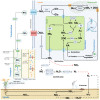Multiple Facets of Nitrogen: From Atmospheric Gas to Indispensable Agricultural Input
- PMID: 36013451
- PMCID: PMC9410007
- DOI: 10.3390/life12081272
Multiple Facets of Nitrogen: From Atmospheric Gas to Indispensable Agricultural Input
Abstract
Nitrogen (N) is a gas and the fifth most abundant element naturally found in the atmosphere. N's role in agriculture and plant metabolism has been widely investigated for decades, and extensive information regarding this subject is available. However, the advent of sequencing technology and the advances in plant biotechnology, coupled with the growing interest in functional genomics-related studies and the various environmental challenges, have paved novel paths to rediscovering the fundamentals of N and its dynamics in physiological and biological processes, as well as biochemical reactions under both normal and stress conditions. This work provides a comprehensive review on multiple facets of N and N-containing compounds in plants disseminated in the literature to better appreciate N in its multiple dimensions. Here, some of the ancient but fundamental aspects of N are revived and the advances in our understanding of N in the metabolism of plants is portrayed. It is established that N is indispensable for achieving high plant productivity and fitness. However, the use of N-rich fertilizers in relatively higher amounts negatively affects the environment. Therefore, a paradigm shift is important to shape to the future use of N-rich fertilizers in crop production and their contribution to the current global greenhouse gases (GHGs) budget would help tackle current global environmental challenges toward a sustainable agriculture.
Keywords: agriculture; environment; nitrogen; sustainable food production.
Conflict of interest statement
The authors declare no conflict of interest.
Figures



Similar articles
-
Planning Implications Related to Sterilization-Sensitive Science Investigations Associated with Mars Sample Return (MSR).Astrobiology. 2022 Jun;22(S1):S112-S164. doi: 10.1089/AST.2021.0113. Epub 2022 May 19. Astrobiology. 2022. PMID: 34904892
-
Integrated eco-strategies towards sustainable carbon and nitrogen cycling in agriculture.J Environ Manage. 2021 Sep 1;293:112856. doi: 10.1016/j.jenvman.2021.112856. Epub 2021 May 26. J Environ Manage. 2021. PMID: 34051535 Review.
-
[Effects of Controlled-release Blended Fertilizer on Crop Yield and Greenhouse Gas Emissions in Wheat-maize Rotation System].Huan Jing Ke Xue. 2024 May 8;45(5):2891-2904. doi: 10.13227/j.hjkx.202305191. Huan Jing Ke Xue. 2024. PMID: 38629551 Chinese.
-
Enhancement of Plant Productivity in the Post-Genomics Era.Curr Genomics. 2016 Aug;17(4):295-6. doi: 10.2174/138920291704160607182507. Curr Genomics. 2016. PMID: 27499678 Free PMC article.
-
Crop microbiome: their role and advances in molecular and omic techniques for the sustenance of agriculture.Planta. 2022 Dec 30;257(2):27. doi: 10.1007/s00425-022-04052-5. Planta. 2022. PMID: 36583789 Review.
Cited by
-
A Longitudinal Analysis of the Impact of Digital Technologies on Sustainable Food Production and Consumption in the European Union.Foods. 2024 Apr 22;13(8):1281. doi: 10.3390/foods13081281. Foods. 2024. PMID: 38672953 Free PMC article.
References
-
- Mellor J.W. Agricultural Development and Economic Transformation: Promoting Growth with Poverty Reduction. Springer; Berlin/Heidelberg, Germany: 2017.
-
- Johnston B.F., Mellor J.W. The role of agriculture in economic development. Am. Econ. Rev. 1961;51:566–593.
-
- Leghari S.J., Wahocho N.A., Laghari G.M., HafeezLaghari A., MustafaBhabhan G., HussainTalpur K., Bhutto T.A., Wahocho S.A., Lashari A.A.J.A.i.E.B. Role of nitrogen for plant growth and development: A review. Adv. Environ. Biol. 2016;10:209–219.
-
- Lawlor D.W., Lemaire G., Gastal F. Plant Nitrogen. Springer; Berlin/Heidelberg, Germany: 2001. Nitrogen, plant growth and crop yield; pp. 343–367.
-
- Lebrun M., Nandillon R., Miard F., Bourgerie S., Morabito D. Assisted Phytoremediation. Elsevier; Amsterdam, The Netherlands: 2022. Biochar assisted phytoremediation for metal (loid) contaminated soils; pp. 101–130. - DOI
Publication types
Grants and funding
LinkOut - more resources
Full Text Sources
Miscellaneous

